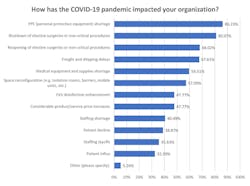Pandemic should motivate Supply Chain to think like ‘scrappy start-up’
The emergence of the novel coronavirus COVID-19 in 2020 and its rapid spread throughout the world not only raised the specter of human mortality while showcasing compassionate care and ingenuity, but it also revealed considerable shortcomings in the global supply chain.
Healthcare Purchasing News surveyed its readers earlier this year to learn how the COVID-19 pandemic impacted their organizations; whether they implemented new policies, products, services or other changes in response; and whether their organizations have a preparation plan in place for any future pandemics or crises. See charts 1, 2 and 3.
HPN Senior Editor Rick Dana Barlow reached out to Amazon Business for an over-arching perspective on the results and what they might indicate for the industry for the remainder of 2020 and through 2021. Bill Kopitke, Amazon Business’ Head of Healthcare, offered some key insights.
HPN: Based on your knowledge and experience and from an Amazon Business perspective, when you look at the findings displayed in the three COVID-19 pandemic-related charts/graphs, what sounds the loudest alarm to you and why?
What we encountered, though, was a rapid adjustment from their traditional purchasing behavior to Amazon Business for PPE and other types of medical equipment and supplies. Though nobody has a crystal ball, if organizations are able to plan ahead, they can be prepared with Amazon Business to gain access to hundreds of thousands of sellers worldwide with millions of products that they might need. The ability to look around corners is in the fabric of our company and we are constantly looking for ways that we can take action today so that it will benefit our customers down the road. Ultimately, right now, it’s important that healthcare providers are aware and remember that Amazon Business can be a step in their pandemic response process.
What are some short-term tips to change attitudes and behaviors rather quickly that can lead to long-term solutions?
Too often in healthcare – and many other industries – business decision makers can be hesitant to take action or embrace a new direction, which leads to unnecessary delays when trying to do the right thing for customers/patients. At Amazon, we listen to our customers’ feedback and use data to innovate and implement a business decision. We also identify “two way doors” during decisions, which are decisions that can be adjusted or reversed based on customer feedback and data. If it turns out that a decision needs an adjustment, we will take the necessary action to improve it. This keeps our mentality of a scrappy start-up. We also continue to incrementally improve a feature or capability after it’s launched: again continually listening to our customers’ feedback and studying data.
If healthcare organizations embrace the status quo, circa February 2020, and do little to address the issues affecting the supply chain within the ensuing months, how will that impact future performance (beyond the obvious, of course)?
For those organizations that have not implemented change, future performance could look like the graph stating the negative impacts from COVID: Supply shortage, freight and shipping delays, space problems, price increases, staffing shortage, etc.
For organizations that have adopted innovative supply chain solutions, such as Amazon Business, they were able to supplement supply needs on backorder, save money and time on shipping, and use Amazon Business for just-in-time inventory replacement to help with space, and minimize staff time with sourcing and procuring. Organizations are learning that Amazon Business has regularly introduced new features that help with both efficiency and spend control. For example, we can integrate with over 90 of the top industry ERP and purchasing systems as a punch-out solution. We also have Guided Buying features to digitally direct or restrict buyers when sourcing on our online store.
This is why 84 of the top 100 healthcare systems in the U.S. use Amazon Business.
The two pie charts show that a healthy majority of respondents believe they have addressed the situation and implemented solutions in reaction to the current pandemic but also have procedures in place to address future crises – including pandemics. Deep down, do you truly think people are prepared and ready for almost every contingency? And how much value do you place in over-preparing for perhaps the most unrealistic scenario anyone can imagine?
A leading forefather of biology and healthcare, Louis Pasteur, once said, “Chance comes to the prepared mind.” There is value to prepare for events that would significantly and negatively impact an organization. While preparing for all scenarios is impossible, we can certainly learn that history may repeat itself.
About the Author
Rick Dana Barlow
Senior Editor
Rick Dana Barlow is Senior Editor for Healthcare Purchasing News, an Endeavor Business Media publication. He can be reached at [email protected].





